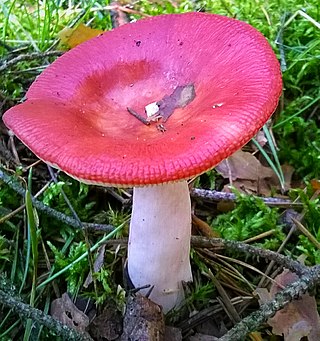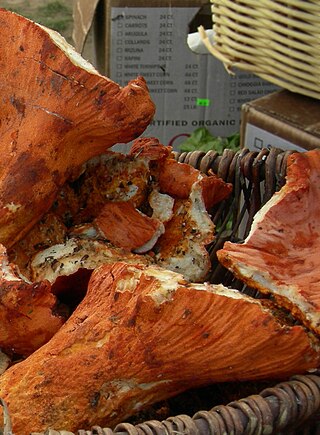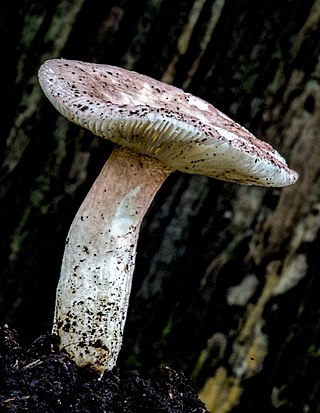
The Russulaceae are a diverse family of fungi in the order Russulales, with roughly 1,900 known species and a worldwide distribution. They comprise the brittlegills and the milk-caps, well-known mushroom-forming fungi that include some edible species. These gilled mushrooms are characterised by the brittle flesh of their fruitbodies.

Russula is a very large genus composed of around 750 worldwide species of ectomycorrhizal mushrooms. They are typically common, fairly large, and brightly colored – making them one of the most recognizable genera among mycologists and mushroom collectors. Their distinguishing characteristics include usually brightly coloured caps, a white to dark yellow spore print, brittle, attached gills, an absence of latex, and absence of partial veil or volva tissue on the stem. Microscopically, the genus is characterised by the amyloid ornamented spores and flesh (trama) composed of spherocysts. Members of the related genus Lactarius have similar characteristics but emit a milky latex when their gills are broken. The genus was described by Christian Hendrik Persoon in 1796.

Russula emetica, commonly known as the sickener, emetic russula, or vomiting russula, is a basidiomycete mushroom, and the type species of the genus Russula. It has a red, convex to flat cap up to 8.5 cm (3.3 in) in diameter, with a cuticle that can be peeled off almost to the centre. The gills are white to pale cream, and closely spaced. A smooth white stem measures up to 10.5 cm (4.1 in) long and 2.4 cm (0.9 in) thick. First described in 1774, the mushroom has a wide distribution in the Northern Hemisphere, where it grows on the ground in damp woodlands in a mycorrhizal association with conifers, especially pine.

Russula vesca, known by the common names of bare-toothed Russula or the flirt, is a basidiomycete mushroom of the genus Russula.

Russula virescens is a basidiomycete mushroom of the genus Russula, and is commonly known as the green-cracking russula, the quilted green russula, or the green brittlegill. It can be recognized by its distinctive pale green cap that measures up to 15 cm (6 in) in diameter, the surface of which is covered with darker green angular patches. It has crowded white gills, and a firm, white stipe that is up to 8 cm (3 in) tall and 4 cm (1.6 in) thick. Considered to be one of the best edible mushrooms of the genus Russula, it is especially popular in Spain and China. With a taste that is described variously as mild, nutty, fruity, or sweet, it is cooked by grilling, frying, sautéeing, or eaten raw. Mushrooms are rich in carbohydrates and proteins, with a low fat content.

Russula cyanoxantha, synonymous with R. xyanoxantha, commonly known as the charcoal burner or variegated russula, is a basidiomycete mushroom, distinguished from most other members of the genus Russula by the fact that its gills do not split, but are soft and flexible. It is one of the most common species of Russula in Europe.

Hypomyces is a genus of parasitic ascomycete fungi found in Europe, North America, Australia, and parts of China. The genus contains 53 species. Better known species include the lobster mushroom and the bolete eater.
Russula subnigricans, known as the rank russula, or Nise-Kurohatsu (Japanese), meaning "false blackening russula" is a basidiomycete mushroom of the genus Russula found in East Asia.

Russula claroflava, commonly known as the yellow russula, yellow swamp russula or yellow swamp brittlegill, is a basidiomycete mushroom of the genus Russula. It is found in wet places under birch and aspen woodlands across Europe and North America. It has a yellow cap, white gills and stipe and bruises grey. It is mild-tasting and regarded as good to eat.

Russula sanguinaria, commonly known as the bloody brittlegill or rosey russula, is a strikingly coloured mushroom of the genus Russula, which has the common name of brittlegills. It is bright blood-red, inedible, and grows in association with coniferous trees. It was previously widely known as Russula sanguinea.

Russula delica is a mushroom that goes by the common name of milk-white brittlegill, and is a member of the genus Russula, all of which are collectively known as brittlegills. It is mostly white, with ochraceous or brownish cap markings, and a short robust stem. It is edible, but poor in taste, and grows in coniferous, broadleaved, or mixed woods. It can be confused with other white Russula species and certain white Lactarius species.

Multifurca is a rare genus of ectomycorrhizal fungi in the family Russulaceae. It was described in 2008, after molecular phylogenetic study had shown that it forms a monophyletic lineage within the family, sister to Lactarius. The genus contains six species known from the United States, Mexico, Costa Rica, India, China, Thailand, Australia, and New Caledonia, but so far has not been reported from Europe, Africa, or South America. Four of those species were formerly classified as Russula section Ochricompactae, and Multifurca furcata was originally described as a Lactarius species.
Lexemuel Ray Hesler was an American mycologist. He was the son of Clinton F. Hesler and Laura Iris. He obtained his B.A. degree with Wabash College in 1911 and his Ph.D. at the University of Cornell in 1914.

Russula persanguinea is a species of agaric fungus in the family Russulaceae. Described as new to science by John Burton Cleland in 1933, it is found in Australia, where it grows singly or in small groups on the ground in eucalypt forests and woodlands. It resembles the common Northern Hemisphere species Russula emetica.

Russula densifolia, commonly known as the crowded russula or the reddening russula, is a species of agaric fungus in the family Russulaceae. It was first described in 1833 and given its current name in 1876. A widespread species, it is found in Asia, Europe, and North America, where it fruits on the ground in mixed and deciduous forests. Fruit bodies (mushrooms) are robust and squat, with caps up to 14.5 cm (5.7 in) in diameter, and stems that are 2–7.5 cm (0.8–3.0 in) long by 1.2–2.5 cm (0.5–1.0 in) thick. The mushrooms are characterized by the red and then black color changes that occur in the flesh when it is bruised, and a relatively thick cap cuticle. Although the mushroom is sold as an edible species in some areas of Asia, it is mild to moderately toxic, and may cause gastrointestinal upset if consumed. Several bioactive compounds have been isolated and identified from the mushroom.

Russula lenkunya is a mushroom in the genus Russula. Found in South Australia, it was first described scientifically by mycologist Cheryl Grgurinovic in 1997.
Russula galbana is a fungus in the family, Russulaceae, found in leaf litter in open forests of Allocasuarina littoralis and Eucalyptus tereticornis in Queensland.
Russula albidoflava is a fungus in the family, Russulaceae, found "in stands of Eucalyptus globulus" in Tasmania.
Russula albobrunnea is a fungus in the family, Russulaceae, found Nothofagus forests of Queensland.













